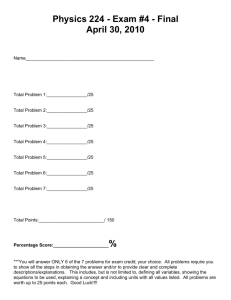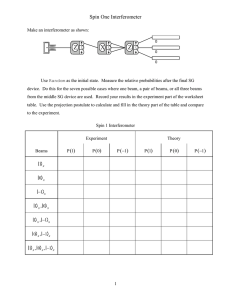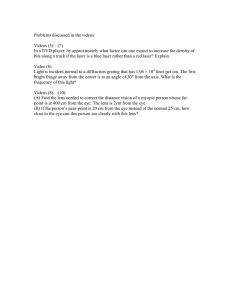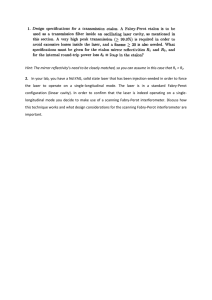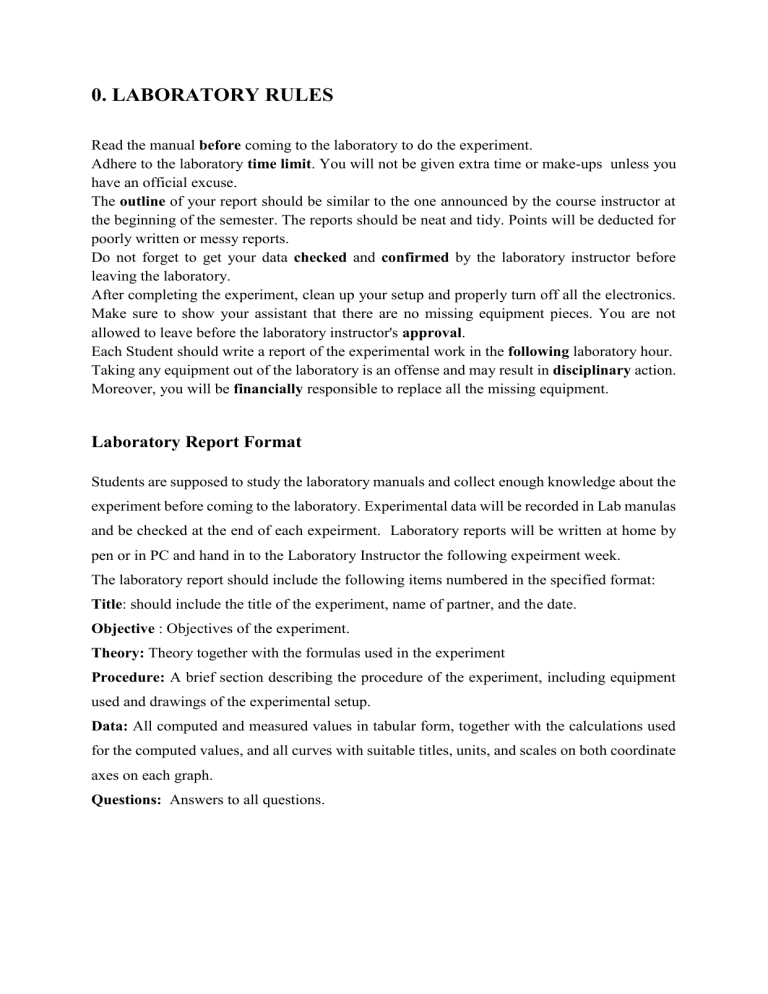
0. LABORATORY RULES Read the manual before coming to the laboratory to do the experiment. Adhere to the laboratory time limit. You will not be given extra time or make-ups unless you have an official excuse. The outline of your report should be similar to the one announced by the course instructor at the beginning of the semester. The reports should be neat and tidy. Points will be deducted for poorly written or messy reports. Do not forget to get your data checked and confirmed by the laboratory instructor before leaving the laboratory. After completing the experiment, clean up your setup and properly turn off all the electronics. Make sure to show your assistant that there are no missing equipment pieces. You are not allowed to leave before the laboratory instructor's approval. Each Student should write a report of the experimental work in the following laboratory hour. Taking any equipment out of the laboratory is an offense and may result in disciplinary action. Moreover, you will be financially responsible to replace all the missing equipment. Laboratory Report Format Students are supposed to study the laboratory manuals and collect enough knowledge about the experiment before coming to the laboratory. Experimental data will be recorded in Lab manulas and be checked at the end of each expeirment. Laboratory reports will be written at home by pen or in PC and hand in to the Laboratory Instructor the following expeirment week. The laboratory report should include the following items numbered in the specified format: Title: should include the title of the experiment, name of partner, and the date. Objective : Objectives of the experiment. Theory: Theory together with the formulas used in the experiment Procedure: A brief section describing the procedure of the experiment, including equipment used and drawings of the experimental setup. Data: All computed and measured values in tabular form, together with the calculations used for the computed values, and all curves with suitable titles, units, and scales on both coordinate axes on each graph. Questions: Answers to all questions. 1. EXPERIMENT #1: Geometric Optics Converging Lens – Image and Object Relationships EQUIPMENT NEEDED: -Optics Bench -Light Source -75 mm Focal Length Convex Lens -Crossed Arrow Target -Component Holders (3) -Viewing Screen. Figure 1: Equipment Setup Introduction Given a lens of any shape and index of refraction, you could determine the shape and location of the images it forms based only on the Law of Refraction. You need only apply the law along with some of the ray tracing techniques you have already used. However, for spherical lenses (and for spherical mirrors as well), there is a more general equation that can be used to determine the location and magnification of an image. This equation is called the Fundamental Lens equation: 1/ d o 1/ di 1/ f where f is the focal length of the lens, and do and di are the distance from the mirror to the image and object respectively (see Figure 1). The magnification of the image is given by the equation: m d i / d o In this experiment, you will have an opportunity to test and apply these equations. NOTE: Instead of the above equation, you may have learned the Fundamental Lens Equation as S o Si f 2 , where S o and S i are the distances between the principle focus of the lens and the object and image, respectively. If so, notice that S o d o f and Si d i f (see Figure 1). Using these equalities, convince yourself that 1 / d o 1 / d i 1 / f and S o Si f 2 are different expressions of the same relationship. Procedure Set up the equipment as shown in Figure 1. Turn on the Light Source and slide the lens toward or away from the Crossed Arrow Target, as needed to focus the image of the Target onto the Viewing Screen. Questions 1.Is the image magnified or reduced? ____________________________________________. 2.Is the image inverted? ______________________________________________________. 3.Based on the Fundamental Lens Equation, what would happen to d i if you increased d o even further? ______________________________________________________________. Table: Data and Calculations 4.What would happen to d i if d o were very, very large? ____________________________. 5.Using your answer to question 4, measure the focal length of the lens. Focal Length = ___________________________________________. Now set d o to the values (in millimeters) listed in the table above. At each setting, locate the image and measure d i . Also measure hi , the height of the image. ( ho is the height of the arrow on the crossed arrow target.) Using the data you have collected, perform the calculations shown in the table. 6.Are your results in complete agreement with the Fundamental Lens Equation? If not, to what do you attribute the discrepancies?_________________________________________ _________________________________________________________________________. 7.For what values of d o were you unable to focus an image onto the screen? Use the Fundamental Lens Equation to explain why. _______________________________________. Additional Questions 1.For a lens of focal length f, what value of d o would give an image with a magnification of one? 2.Is it possible to obtain a non-inverted image with a converging spherical lens? Explain. 3.For a converging lens of focal length f, where would you place the object to obtain an image as far away from the lens as possible? How large would the image be? 2. EXPERIMENT #2: Michelson Interferometer Interference Theory A beam of light can be modeled as a wave of oscillating electric and magnetic fields. When two beams of light meet in space, these fields add according to the principle of superposition. At each point in space, the electric and magnetic fields are determined as the vector sum of the fields of the separate beams. If the two beams of light originate from separate sources, there is generally no fixed relationship between the electromagnetic oscillations in the beams. If two such light beams meet, at any instant in time there will be points in space where the fields add to produce a maximum field strength. However, the oscillations of visible light are much faster than the human eye can apprehend. Since there is no fixed relationship between the oscillations, a point at which there is a maximum at one instant may have a minimum at the next instant. The human eye averages these results and perceives a uniform intensity of light. However, if the two beams of light originate from the same source, there is generally some degree of correlation between the frequency and phase of the oscillations of the two beams. At one point in space the light from the beams may be continually in phase. In this case, the combined field will always be a maximum and a bright spot will be seen. At another point the light from the two beams may be continually out of phase and a minima, or dark spot, will be seen. Thomas Young was one of the first to design a method for producing such an interference pattern. He allowed a single, narrow beam of light to fall on two narrow, closely spaced slits. Opposite the slits he placed a viewing screen. Where the light from the two slits struck the screen, a regular pattern of dark and bright bands became visible. When first performed, Young’s experiment offered important evidence for the wave nature of light. Young’s slits function as a simple interferometer. If the spacing between the slits is known, the spacing of the maxima and minima can be used to determine the wavelength of the light. Conversely, if the wavelength of the light is known, the spacing of the slits could be determined from the interference patterns. In 1881, some 78 years after Young introduced his two-slit experiment, A.A. Michelson designed and built an interferometer using a similar principle. Originally Michelson designed his interferometer as a method to test for the existence of the ether, a hypothesized medium in which light could propagate. Due in part to his efforts, the ether is no longer considered a viable hypothesis. Michelson’s interferometer has become a widely used instrument for measuring the wavelength of light, and for using the wavelength of a known light source to measure extremely small distances. Figure 1 shows a diagram of a Michelson interferometer. A beam of light from the laser source strikes the beam-splitter. The beam-splitter is designed to reflect 50% of the incident light and transmit the other 50%. The incident beam therefore splits into two beams; one beam is reflected toward mirror M 1 , the other is transmitted toward mirror M 2 . M 1 and M 2 reflect the beams back toward the beam-splitter. Half the light from M 1 is transmitted through the beam-splitter to the viewing screen and half the light from M 2 is reflected by the beam-splitter to the viewing screen. Figure 1: Diagram of a Michelson Interferometer In this way the original beam of light splits, and portions of the resulting beams are brought back together. The beams are from the same source and their phases highly correlate. When a lens is placed between the laser source and the beam-splitter, the light ray spreads out. An interference pattern of dark and bright rings, or fringes, is seen on the viewing screen, as shown in Figure 2. Figure 2: Interference Pattern NOTE: Do not be concerned if your pattern shows irregularities or has fewer fringes. As long as fringes are clearly visible, measurements will be accurate. Since the two interfering beams of light were split from the same initial beam, they were initially in phase. Their relative phase when they meet at any point on the viewing screen, therefore, depends on the difference in the length of their optical paths in reaching that point. By moving mirror M 2 , the path length of one of the beams can be varied. Since the beam traverses the path between M 2 and the beam-splitter twice, moving M 2 1/4 wavelength nearer the beam-splitter will reduce the optical path of that beam by 1/2 wavelength. The interference pattern will change; the radii of the maxima will be reduced so they now occupy the position of the former minima. If M 2 is moved an additional 1/4 wavelength closer to the beam-splitter, the radii of the maxima will again be reduced so maxima and minima trade positions. However, this new arrangement will be indistinguishable from the original pattern. By slowly moving M 2 a measured distance d m , and counting m, the number of times the fringe pattern is restored to its original state, the wavelength of the light ( ) can be calculated as: =2d/m If the wavelength of the light is known, the same procedure can be used to measure d m . Equipment Needed • Interferometer base with built-in micrometer and leveling feet • Movable mirror • Beam splitter • Three point adjustable fixed mirror • Vacuum cell for measuring the index of air refraction • Beam expanding lens with component holder • Fitted case Laser Source. (A low power laser that operates in the visible range) Vacuum pump Figure 3: Michelson Interferometer CAUTION: Do not use the vacuum chamber with a compressor; it is not built to withstand positive pressures Setup The Interferometer The Michelson Interferometer is shown in Figure 3. The alignment of the beamsplitter and the movable mirror, M 2 , is easily adjusted by loosening the thumbscrews that attach them to the interferometer. The fixed mirror, M 1 , is mounted on an alignment bracket. The bracket has two alignment screws to adjust the angle of the mirror. The movement of M 2 toward and away from the beam-splitter is controlled and measured using the micrometer knob. Each division of the knob corresponds to 1 Micrometer ( 10 6 meter) of mirror movement. The Movable Mirror Figure 4: Mirror Movement Mechanism To measure the wavelength of light, the movement of M 2 must be measurable for distances about 10 6 meters. Also, as the mirror moves, its reflective surface must remain perpendicular to the axis of the incident light beam. A taut-band carriage is used to maintain the alignment of the reflective surface of M 2 as it moves. The mirror is mounted in a cradle that is fixed to two semi-rigid aluminum bands. With this set-up the mirror is free to move, but its movement is constrained to a line parallel with the beam axis. The micrometer mechanism controls and measures the movement of M 2 . The cradle of M 2 is attached to a mylar strip that is attached to a lever arm. The displacement of the lever is controlled with the micrometer knob. Suppose the micrometer knob is turned so it pushes the lever in by a distance d (see Figure 4). The angle of the lever arm changes by an amount such that, d R tan as shown. Since the angle change is always small, R tan R , to a close approximation. This change in the lever arm angle causes the mylar strip to be pulled further around the lever post by an amount r , where r is the radius of the lever post. The mirror is therefore pulled away from the beam-splitter by the amount, r . In this way, a relatively large displacement of the lever ( d R ) results in a much smaller displacement of the mirror ( d m r ). By selecting appropriate values for r and R , the motion of M 2 . is controlled so that each division on the micrometer dial corresponds to 1 micron of mirror movement. Aligning the Interferometer NOTE: This alignment procedure is for those using a PASCO scientific Optics Bench. If you are not using an Optics Bench, tape a straightedge to a flat level surface. The straightedge will provide a substitute for the alignment rail of the optics bench. 1. Place the laser and the interferometer on the Optics Bench, approximately 10 - 20 cm apart (Figure 5). Be sure that the edges of both units are flush against the alignment rail of the bench. Place a viewing screen as shown. (A blank sheet of white paper taped to the cover of a book provides a convenient screen.) Turn on the laser. 2. Loosen the thumbscrew that holds the beam-splitter and rotate the beam-splitter so it is out of the beam path of the laser as shown in Figure 5. Then loosen the thumbscrew that holds M 2 , the movable mirror. Adjust the rotation of M 2 so the laser beam is reflected directly back toward the aperture of the laser. (The reflected beam need not be at the same height as the incident beam, but it should strike the front panel of the laser along a vertical line through the aperture.) Hold M 2 in position and tighten the thumbscrew. 3. Rotate the beam-splitter so its surface is at an angle approximately 45o with the incident beam from the laser (see Figure 6). You will see two sets of laser spots on the viewing screen, corresponding to the two paths that the beam takes in reaching the screen. (Each path results in more than one laser spot because of multiple reflections within the beam-splitter.) Adjust the beam-splitter so the two sets of laser spots are as close as possible, then tighten the thumbscrew to secure the beam-splitter. 4.Using the alignment screws, adjust the angle of M 1 until the two sets of laser spots are superimposed on the viewing screen (the two brightest spots must be superimposed). 5. Place the lens holder on the optical bench as shown in Figure 7. Be sure its edge is flush against the alignment rail. Then place the 18 mm focal length lens on the lens holder (it attaches magnetically). Adjust the position of the lens on the holder so the light from the laser, now spread out by the lens, strikes the center of the beam-splitter. If you have performed the alignment correctly, you will see an interference pattern of concentric rings on the viewing screen. If the alignment is not just right, the center of the fringe pattern may not be visible on the screen. Adjust the alignment screws on M 1 very slowly as needed to center the pattern. Figure 5: Adjusting M 1 Figure 6: Aligning the Laser spots Figure 7:Positioning The Lens Measuring the Wavelength of Light Theory In many scientific and industrial uses of interferometers, a light source of a known wavelength is used to measure incredibly small displacements - about 10 6 meters. However, if you know the distance of mirror movement, you can use the interferometer to measure the wavelength of a light source. In this experiment you will use the interferometer to measure the wavelength of your laser light source. Procedure 1. Align the laser and interferometer as described in the preceding section, so an interference pattern of circular fringes is clearly visible on your viewing screen. 2. Adjust the micrometer knob so the lever arm is approximately parallel with the edge of the interferometer base. In this position the relationship between knob rotation and mirror movement is most nearly linear. 3. Turn the micrometer knob one full turn counterclockwise. Continue turning counterclockwise until the zero on the knob is aligned with the index mark. NOTE: Whenever you reverse the direction in which you turn the micrometer knob, there is a small amount of give before the mirror begins to move. This is called mechanical backlash, and is present in any mechanical system involving reversals in direction of movement. By beginning with a full counterclockwise turn, and then turning only counterclockwise when counting fringes, you can eliminate backlash in your measurement. 4.If you are using a blank piece of paper as your viewing screen, make a reference mark on the paper between two of the fringes. You will find it easier to count the fringes if the reference mark is one or two fringes out from the center of the pattern. 5. Rotate the micrometer knob slowly counterclockwise. Count the fringes as they pass your reference mark. Continue until a predetermined number of fringes has passed your reference mark (count at least 20 fringes). As you finish your count, the fringes should be in the same position with respect to your reference mark as they were when you started to count. 6. Record d m , the distance that the movable mirror moved toward the beam-splitter as you turned the micrometer knob. Remember, each division on the micrometer knob corresponds to one micron ( 10 6 meters) of mirror movement. d m = _______________ 7. Record m, the number of fringes that crossed your reference mark. m = _______________ Data Analysis: 1. Calculate the wavelength of the laser light ( 2d m m ). 2. Calculate the percentage difference between your measured value for the wavelength of the laser light and the value recorded in the laser specifications. (Check with your teaching assistant for the laser specifications.)


